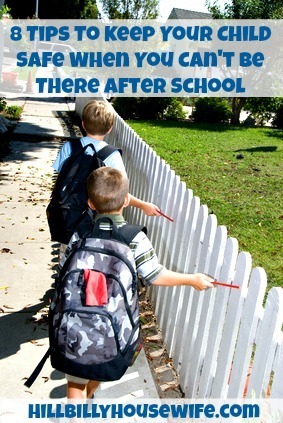8 Tips To Keep Your Child Safe When You Can’t Be There After School
Sometimes its necessary to leave our children at home alone even as much as we’d rather not, it’s sometimes unavoidable. When your child walks home from school, lets himself into the house, and spends time in the house alone, it can result in anxiety for parents.
With a few tips and solid rules in place for your child, you can help keep him safe at home until you get there, and save yourself a little bit of worry. Here are a few basics to keep in mind when your child must be alone at home:
Calm His Fears
The first thing you will want to do is talk to your child honestly about he feels about being home alone. You may calm your child’s fears by going over the safety rules, such as keeping the doors and windows lock and to never answer the door to strangers. Sometimes it’s the unknown that frightens a child. If your child knows he won’t have to answer the door or the telephone, that may be enough to put his mind at ease. By having a frank discussion with your child about his fears you will be able to get to the bottom of it and put his mind at ease as well.
You’re Still The Boss
It’s important that your child know that you are still in charge even when you are not at home. Rules help keep people safe and your rules must be followed to the letter or there will be consequences. Lay out rules and consequences that cannot be mistaken, argued, or misunderstood. Even posting them on a bulletin board or refrigerator will help reinforce what is acceptable and what’s not.
Who to Call in an Emergency
Sometimes emergencies pop up and your child needs to know exactly what to do in case of an emergency. Be sure your child knows how to contact the police and fire department. Have all that type of information right by every phone in the house and on speed dial. Explain to your child what constitutes an “emergency” as kids have a wide range of emergency-like situations that could crop up, at least in their mind.
Memorize Personal Information
Your child needs to know his full name, phone number and address. Also teach your child your full name, your cell phone number, the name of where you work and your work phone number. Include the numbers and names of other people who are your back-up support, such as uncles and aunts, grandparents and friends.
 Rules of the House
Rules of the House
Talk about the rules of the house that your child must follow when you’re not home. Discuss simple things like doing homework, what snacks to have, and what has to be completed before he can watch TV or play video games.
On the more important issues, be very clear. Are friends allowed over while you are gone? If there are friends you will allow and some you won’t, be precise about which ones. Do you want your child answering the door while you’re gone? Is your child permitted to answer the phone? Why do either when someone at the door can come back when you’re home or just leave you a message on voicemail.
Make your rules crystal clear so there are no excuses for mix ups and confusion.
Getting Home Safely
The most nerve-racking part about your child staying home alone for most parents is the walk home from school. Before you allow your child to walk home alone, go over the route with him a few times. Remind your child never to deviate from the route. No matter how tempting it may be to go see that little puppy on the next block or stop by his friend’s house just a street over remind him if it’s not on the route then it’s not allowed. Walk the route several times together and pick out safe areas both on the route and near your home where your child can get help if needed. These safe areas could be places such as office buildings, stores or the house of a family member or trusted friend. Make sure your child understands which places are safe.
Where to Keep the House Key
Decide whether you will hide a house key at the house or if your child will carry a key with him. If you hide one, be sure it is somewhere safe where your child won’t be seen getting the key. If your child carries a key, be sure someone who is available has a spare. Teach your child safe habits which include locking the door immediately after going inside. Then have child call you right away to let you know he has arrived home safely. You can then ask your child a few questions about his day while he walks through the house with the phone just reassuring you and himself that everything appears to be in order.
Is Everything in Order?
Last but not least, make sure you explain to your child that before they enter the house, look around to see if anything is out of the ordinary in the yard, driveway, at the front step, or anywhere in the surrounding area. If something doesn’t seem right, your child should go to the safe area in the neighborhood you picked out and call you. If your child is in the house and spots something that seems odd or out of place (an overturned chair, a broken window, a leaking pipe, a fire alarm going off, etc.) your child should go to the safe area you have agreed on and call you. Be sure your child understands the difference between calling you and calling the police. The most important thing is that your child is aware of his or her surroundings and that there is a safe area to go to where there are people who can help.
In a perfect world you would always be there for your child when he gets home from school. But, there are times when this just won’t happen. Preparing yourself and your child for this situation is important both for your child’s safety and for your sanity. When you lay out the rules and give your child a clear explanation of what to do in all situations, everyone can rest easier.
To support the blog, check out the HBHW eBooks available on Amazon. Thank you!
Disclosure: Some of the links below are affilate links, meaning, at no additional cost to you, I will earn a commission if you click through and make a purchase.

